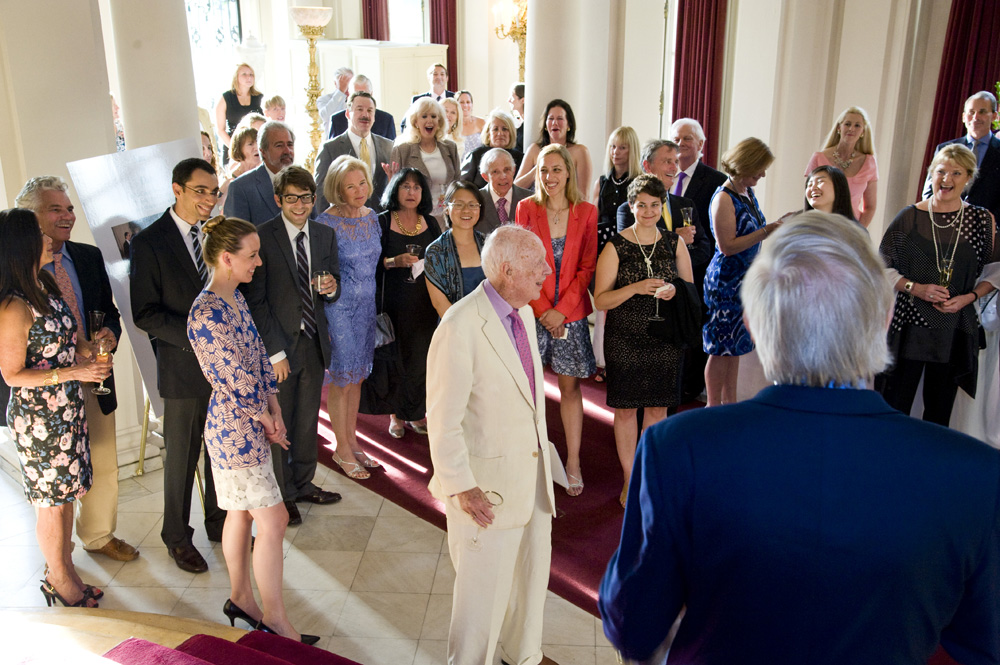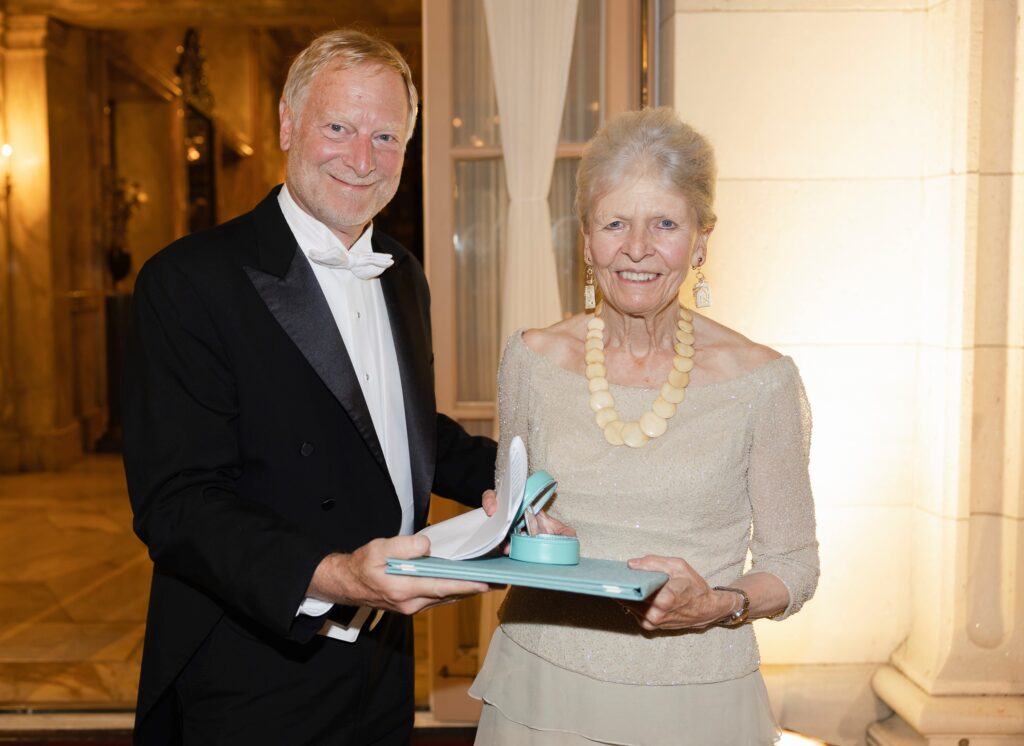James D. Watson Award
James Watson, Ph.D., 2014
Cold Spring Harbor Laboratory
Joan A. Steitz, PhD, 2021
Yale University
(James Watson pictured with Hope Funds Fellows, Trustees and Donors; and Joan Steitz accepting the Award in 2021)
The James D. Watson Award was established by the Board of Trustees on December 13, 2013 to recognize discoveries that fundamentally change science and our understanding of life; the types of discoveries made by Sir Isaac Newton, Charles Darwin, and James Watson, Dr. Watson being the first recipient.
About James Dewey Watson, Ph.D.
James Dewey Watson is best known as a co-discoverer of the structure of DNA in 1953 with Francis Crick. He was awarded the 1962 Nobel Prize in Physiology or Medicine along with Crick and Maurice Wilkins, University College London. The publication of the double helix structure of DNA can be regarded as a turning point in science: human understanding of life was fundamentally changed and the modern era of biology began.
Dr. Watson received his B.S. from the University of Chicago and his Ph.D. from Indiana University with Dr. Salvador Luria as his advisor. He did postdoctoral research with the biochemist Dr. Herman Kalckar in Copenhagen. From 1952 to 1956, Dr. Watson worked at the University of Cambridge’s Cavendish Laboratory in England, where he first met his future collaborator and friend Francis Crick. In late February 1953, Watson and Crick deduced the double helix structure of DNA and its alphabet of bases represented by the letters ATGC which spell out the code of life and is always paired in a way to pass on genetic information faithfully with every cell division. Near the end of their paper Watson and Crick concluded, with what is regarded as the most famous understatement in science, “It has not escaped our attention that the specific pairing we have postulated immediately suggests a possible copying mechanism for the genetic material.” In fact most scientists regard the elucidation of the double helix as one of the most important research achievements ever, a discovery that will be remembered along with the work of Newton, Darwin and Einstein.
Dr. Watson’s illustrious career only began with the double helix. From 1956 to 1976, he was on the faculty of the Harvard University Biology Department, promoting research in molecular biology. From 1968 Dr. Watson served as director of Cold Spring Harbor Laboratory. At CSHL, he shifted his research emphasis to the study of cancer, along with making CSHL a world leading research center in molecular biology. In 1994, he started as president and served for 10 years. He was then appointed chancellor, serving until 2007, and is currently chancellor emeritus. Between 1988 and 1992, Dr. Watson played a leading roll in obtaining public support for the National Institutes of Health, helping to establish the Human Genome Project and he served as the project’s first director.
About Joan A. Steitz, Ph.D.
Dr. Steitz is Sterling Professor of Molecular Biophysics and Biochemistry at Yale University and Investigator at the Howard Hughes Medical Institute. She is known for her discoveries involving RNA. Joan received her B.S. degree in chemistry from Antioch College, Ohio and studied molecular biology in Alex Rich’s lab at MIT as an Antioch “coop” intern. She was accepted to Harvard Medical School, but having been excited by bench-science in the laboratory of Joseph Gall at the University of Minnesota, she declined the invitation to Harvard Medical School and instead applied to Harvard’s program in biochemistry and molecular biology. She was the first female graduate student to join the laboratory of James D. Watson. Dr. Steitz completed her postdoctoral research at the University of Cambridge (UK), where she collaborated with Francis Crick, Sydney Brenner, and Mark Bretscher. At Cambridge, Dr. Steitz discovered the exact sequences on mRNA at which bacterial ribosomes bind to produce proteins. In 1969 she published a seminal paper in Nature showing the nucleotide sequence of the bound start points. In 1970, Dr. Steitz joined the faculty at Yale. In 1975, she published the research for which she is widely known, demonstrating that ribosomes use complementary base pairing to identify the start sites on bacterial mRNA. Starting in 1979 with her MD/PhD student Michael Lerner, she identified novel cellular entities called snRNPs and defined their roles in splicing. Her later characterization of another kind of snRNP particle, snoRNPs, demonstrated conclusively that introns are not junk-DNA. Dr. Steitz has served as scientific director of the Jane Coffin Childs Memorial Fund for Medical Research (1991-2002) and as editorial board member of Genes & Development. She has been honored with many awards, including the National Medal of Science, the Lasker Prize and the Wolf Prize, and membership in the National Academy of Sciences and the Royal Society of London (Foreign Member).


